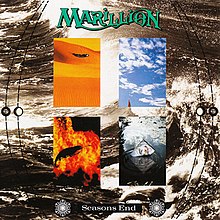Seasons End
| Seasons End | ||||
|---|---|---|---|---|
 |
||||
| Studio album by Marillion | ||||
| Released | 25 September 1989 29 September 1997 (two-disc edition) |
|||
| Recorded | Hook End Recording Studios, Oxfordshire, 1989 | |||
| Genre | Neo-progressive rock | |||
| Length | 47:35 (vinyl edition) 50:55 (single CD edition) 1:39:25 (double CD edition) |
|||
| Label |
EMI (Worldwide) Capitol Records (Canada, US) |
|||
| Producer | Marillion & Nick Davis | |||
| Marillion chronology | ||||
|
||||
| Singles from Seasons End | ||||
|
||||
| Professional ratings | |
|---|---|
| Review scores | |
| Source | Rating |
| Allmusic | |
| Progressiveworld.net | |
| Sputnikmusic | 3.7/5 |
Seasons End is the fifth studio album by British rock band Marillion, released in 1989. The album was the first to feature current lead singer Steve Hogarth, following the departure of former vocalist Fish in late 1988. It reached number 7 on the UK Albums Chart.
Following the departure of Fish, Marillion started to audition singers while writing the new album, and they eventually chose Steve Hogarth. The music for Seasons End was mostly finished by the time Hogarth joined Marillion, and only a couple of songs on it actually have some pieces written by him, most notably "Easter" and "The Space". A number of the lyrics were written by John Helmer, who the band had commissioned before Hogarth joining. He would continue to contribute lyrics throughout the 1990s.
Much of the music on Seasons End had been composed while Fish was still in the band. The bonus disc of the 1999 re-issue of Clutching at Straws contains a number of nascent versions of songs that would end up on Seasons End with vocals and lyrics by Fish, these demos having been produced during the writing sessions for the ill-fated fifth studio album with Fish. (A number of the lyrical concepts from these demos, such as The Voice in the Crowd, would later resurface on Fish's debut studio album, Vigil in a Wilderness of Mirrors.)
The album was produced jointly by Marillion and Nick Davis (who would go on to work with Genesis and associated acts).
As with Marillion's previous two studio albums, three singles were released from Seasons End. The first single was "Hooks in You" in August 1989, followed by "The Uninvited Guest" in November and "Easter" in March 1990.
As Mark Wilkinson, who had designed all previous Marillion covers, had left together with Fish, the album also marked a turning point in the band's visual style, towards a more "modern", photographic look created by Bill Smith Studio. The four square fields dominating the cover symbolise the four classical elements, earth, air, water and fire (clockwise from top left). At the same time, the cover contained some references to the past: It used the band's original logo, which had been replaced with a "modernised" version on the previous album Clutching at Straws and related releases as well as on B'Sides Themselves (although the 1988 live retrospective The Thieving Magpie also used it). The feather in the "desert" square is a reference to the image of the "magpie" found on Misplaced Childhood (1985), the "sky" square contains a fragment of the "Jester's" dress introduced on Script for a Jester's Tear (1983), the chameleon in the "fire" square appears on Script for a Jester's Tear, Fugazi (1984) and Misplaced Childhood; the painting with the clown's face falling into the water upside-down is taken from the Fugazi cover. Also, the vinyl version returned to the gatefold format that had been abandoned on the previous studio album.
...
Wikipedia
